This is a guest post by Darren Davis. It originally appeared on his excellent blog, Adventures in Transitland, which we encourage you to check out. It is shared by kind permission.
Context
Queensland launched 50 cent flat fares across all urban bus networks in the state in August 2024 (including free transfers), initially as a cost of living relief measure implemented in the lead-up to the October 26 2024 state election. In that election, a new state government was elected which has continued 50 cent flat fares and made them permanent. 50 cent fares have been in place for eight months now so it’s timely to have a look at their impact.
50 cent fares patronage impacts
The state government noted in a media release the following achievements in South East Queensland (SEQ) since the introduction of 50 cent flat fares.
- Patronage increased on all modes of SEQ public transport between August 5 and the end of October:
- Bus: Increase of 14.3 per cent on the same period in 2023.
- Train: Increase of 17.9 per cent on the same period in 2023.
- Gold Coast Light Rail: Increase of 22.1 per cent on the same period in 2023.
- Ferries (Brisbane River and Southern Moreton Bay Islands): Increase of 43.9 per cent on the same period in 2023.
- SEQ across all modes: Increase of 16.7 per cent on the same period in 2023.
- SEQ public transport patronage between August 5 and the end of October 2024 was up 5.1 per cent on the same period pre-COVID
Of note is that South East Queensland has 72 per cent of the state’s population but 94 per cent of the state’s urban public transport trips.
In looking at the various further out parts of SE Queensland, the impacts have been universally positive. For example:
- Noosa Shire (+35 per cent)
- City of Logan (+20 per cent)
- City of Gold Coast (+21 per cent)
- Sunshine Coast Council (+37 per cent).
And in regional Queensland, there have also been big benefits averaging 20 per cent across all networks with strong outcomes in:
- Gympie (+49 per cent)
- North Stradbroke Island (+39.29 per cent)
- Mackay (+40.92 per cent)
- Townsville (+49.29 per cent).
All of these figures are compared to the same period in 2023.
Let me be the first to say that improving public transport frequency and reliability are far more important than reducing price in increasing patronage. It goes without saying that you can’t use public transport that doesn’t exist, no matter how cheap it is.
50 cent fares and affordability
But, on the other hand, 50 cent fares pretty much kills any notion in public discourse that people can’t afford public transport. Prior to 50 cent fares, a single peak journey from Varsity Lakes in the southern Gold Coast to Brisbane cost $14.55, meaning over a 96% reduction in public transport costs for southern Gold Coast commuters to Brisbane city centre.
Even for the cheapest one zone peak Go Card fare of $3.55, the saving with 50 cent fares is 86 per cent.
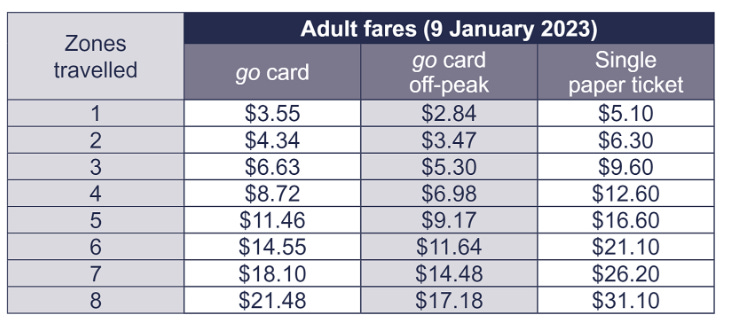
There is now no difference between card and cash fares, noting that cash fares are only available for purchase at a ticketing machine at railway stations, ferry terminals, light rail stops and busway stations.
Unsurprisingly, some of the biggest patronage uplift has been on longer-distance journeys from the Gold Coast and Sunshine Coast to Brisbane. This is particularly important given their role as domestic and international visitor destinations. Given that free transfers are included in the 50 cent fare, the longest possible journey for 50 cents would be from Gympie in the north to the New South Wales border, a distance of 276 kilometres, or less than 0.2 cents per kilometre. Which is pretty good value for money at a time when cost of living is top of mind in Australia and elsewhere.
Annual savings from 50 cent fares to Brisbane City Centre
1 zone fare – Kedron Brook – 10 km – 3 days a week – $1,092.00
3 zone fare – Ipswich – 37 km – 3 days a week – $2,558.40
6 zone fare – Varsity Lakes – 85 km – 3 days a week – $4,383.60
8 zone fare – Noosa Heads – 150 km – 3 days a week – $6,545.76
Even for the cheapest former fares, there’s still a return flight to Bali in savings from three day a week commuting over a year. For medium to long-distance commuters, this would likely run to a return flight to Europe.
The example of airfares is purely illustrative as a lot of Aussie households are under significant financial and mortgage stress. And a lot of the money saved will have gone to household budgets for everyday items.
As at 30 November 2024, the Queensland government estimated that Queenslanders had already saved $100 million, in less than four months, based on travel patterns and patronage in the lead-up to 50 cent fares.
And I have noticed a significant reduction in fare evasion as a result of 50 cent fares. Which would mean that some of the patronage increase is coming from people who were already travelling before but are now paying for the journey.
An interesting downside of 50 cent fares is that there is no such thing as a concession fare as all fares are 50 cents, except for the following groups who still get free travel.
- Children aged 4 years old and under
- Totally and Permanently Incapacitated/ Extreme Disablement Adjustment Veteran Travel card holders
- Vision Impairment Travel Pass holders
- Translink Access Pass holders
- go access Travel Trainer card holders
So, apart from these relatively limited groups, everyone pays the same and can use any form of Go Card to travel. This means that it is no longer possible to get an accurate breakdown of various forms of concession travel such as children, tertiary students and older adults.
On the other hand, the recent completion of the smart ticketing project in SE Queensland, where customers can pay for their journey with a contactless Visa, Mastercard and American Express credit or debit card, including those in a digital wallet, overcomes a key barrier to public transport use which was the requirement to have a Go Card, especially in SE Queensland where buses do not accept cash. This is itself is likely to generate increased patronage. According to the Australian Broadcasting Corporation, one of the earliest stages of the smart ticketing roll-out on Brisbane River ferries led to 20 per cent of fares being by credit or debit cards, including digital wallets on phones.
Travel time comparison
In the case of travel from the southern Gold Coast to Queen Street mall in Brisbane City centre, assuming needing to be there by 8:25am, the choice for mid-week in early March is between:
- Car: 1 hour 10 minutes to 2 hours. Therefore needing to leave at 6:25am to guarantee an 8:25am arrival. Note that the car travel time doesn’t appear to including walking time as 141 Queen Street is on the Queen Street Mall so not accessible by car.
- Train: 1 hour 19 minutes on train + 11 minutes walking = 1 hour 30 minutes. The all-day Gold Coast Line express pattern has substantial sections of 140 km/h running between Beenleigh to Varsity Lakes, taking 30 minutes to cover 50 kilometres, including station stops. And Cross River Rail will reduce the walking time from 11 minutes from Central Station to 3 minutes from the new Albert Street Station.
In the case of rail (and busway) services, travel times are much more predictable and reliable than for car travel. Effectively, you save 30 minutes by travelling by train and of course, time on board a train (or bus, or ferry, or tram) can be put to better use than time spend driving.
So where competitive travel times and affordable fares come together, the incentive to mode shift from 50 cent fares becomes that much stronger. As always, it’s the service that drives patronage, supported by fares, not the other way around.
Park and Ride and Hide and Ride
The flat fare also gets rid of any fare zone boundary issues where there is strong park and ride (or hide and ride) capacity issues around fare zone boundaries. This has had significant impacts at stations that were on zone boundaries at express train stops. There is no price incentive to drive to cheaper fare zones. But also counterbalancing impacts at outer stations on the network which are likely to be experiencing increased parking pressure in the middle of the week, when more people are working from the office in Brisbane city centre.
Impact on parking in Brisbane City Centre
One of the big impacts of 50 cent fares has been the plummeting price of all-day parking in Brisbane city centre. Prior to 50 cent fares, all-day parking cost around $80 per day. Clearly, 50 cent fare has had an impact on parking demand as early bird parking deals are now available around $30 per day.
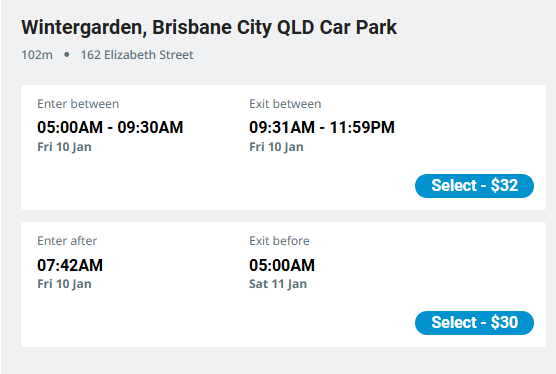
While $30 per day is a lot cheaper than the previous $80 or more per day, it’s also still a lot more expensive than $1 per day return travel on public transport. But somewhat ironically, 50 cent fares is also leading to significant cost savings for entrenched car drivers who are saving around $600 per month if they work in the city centre three weekdays a week and a whopping $1,000 per month if they work on site in the city centre five weekdays a week (noting that weekend parking prices are much cheaper than weekday parking prices).
It has to be a supremely ironic outcome of 50 cent fares that the people who have saved the most money are city centre car commuters whether or not they switched to public transport as a result of 50 cent fares. Noting of course that they will save a lot more if they switch to public transport than driving and parking.
Final thoughts
In 2022/2023, SEQ public transport patronage was 153.3 million, increasing to 167.8 million in 2023/2024. But if South East Queensland sustains the current 5.1% increase in patronage over pre-Covid patronage, patronage could reach close to 200 million trips in the 2024/2025 financial year, noting that the significant network impacts of ex-tropical cyclone Alfred may put a dent in this.
South East Queensland public transport patronage
2018/2019 – 189.7 million
2022/2023 – 153.3 million
2023/2024 – 167.8 million
2024/20025 – ≈200 million? (guesstimate only)
If realised, that would be a patronage increase of 30 per cent in two years. Given that there has been only very limited changes in public transport services in that period, that increase is really only attributable to post-pandemic patronage recovery and the impact of 50 cent fares.
But 50 cent fares come at a price in foregone revenue which has to be paid for. As always, there is an opportunity cost in money that could have been invested in increased frequency, span and coverage of services. This is estimated to cost Queensland $A1.5 billion over four years with the first six months alone coming in at a cost of $A181 million in foregone farebox revenue.
And, as noted previously, no fare, no matter how cheap or even free, can incentivise people to use public transport services that either don’t exist, or are unattractive to use due to lack of frequency, span, coverage or disproportionate travel time when compared with driving.
This post, like all our work, is brought to you by the Greater Auckland crew and made possible by generous donations from our readers and fans. If you’d like to support our work, you can join our circle of supporters here, or support us on Substack!

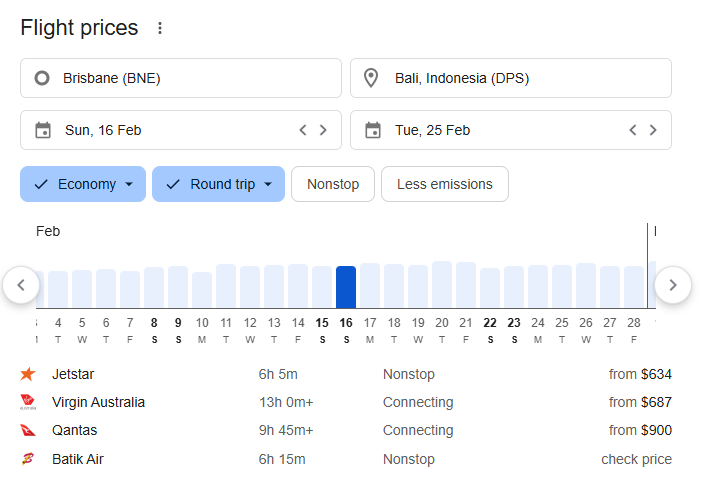
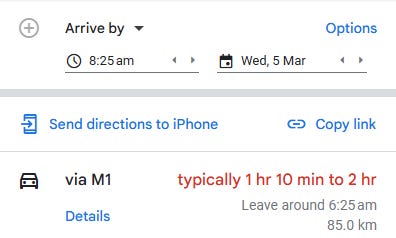
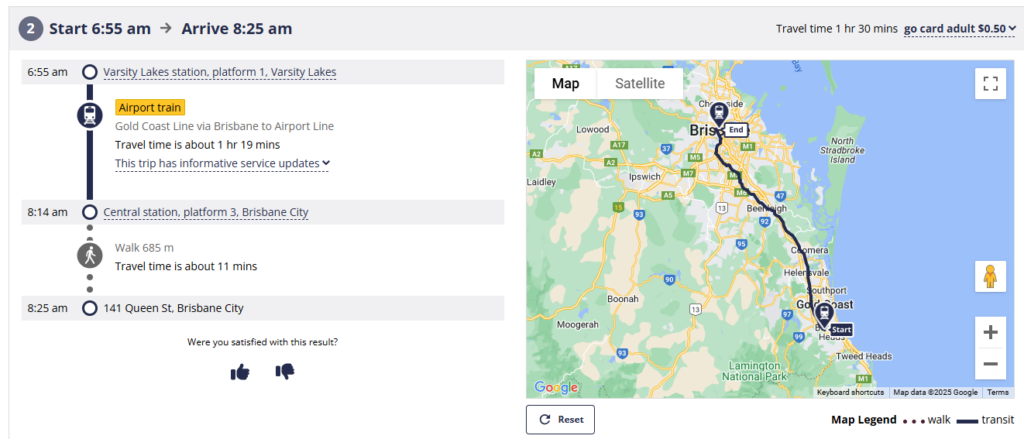

 Processing...
Processing...
For some reason Australia has some good ideas, and it usually takes us a decade or so to attempt similar activities (we are not enough people).
So, let’s build some more apartments in our city, bring the whole motu to Auckland, and create an Australian size city!
In the meantime, make public transport free, because whatever it costs, it is less than the money we lose with congestion, so even dyscalculia would blame the cars for our economic dysfunction, and ensure that those of us who do not drive were rewarded for our dedication to the betterment of our city.
bah humbug
Would be cool wouldn’t it, except NZ has no money left labour blew it all and National shows no signs of pulling back in any significant way. Maybe if we banned AT from doing speed bumps, cycleways, road upgrades and also asked AC to cut any unnecessary spending like changing out English signs for multi language ones etc. Then we might just be able to afford it along with the congestion charging scheme.
orrrr Mount Colah we could cancel the billions of dollars of unnecessary motorways for government level subsidy of better transport options, not a few tens-of-thousands-of-dollars of street calming measures.
Mind you, you car heads tend to be mathematically illiterate so i could be talking to a brick wall here.
Is the Airport line also now a 50c fare?
If we had a large amount of money to supplement PT, I’m not sure slashing fares is the best way to do it.
* It raises significant equity issues. The areas best served by PT are well off, inner areas — giving cheap PT gives more to those who may not need it.
* Many poorer, outer areas are still poorly served by PT.
* Anything that encourages additional trips during peak times is really expensive to serve.
Instead:
* Journeys which start/end in the CBD (especially during peak), shouldn’t receive fare discounts. These trips are typically competing with parking in town — which is already very expensive (and it’s not clear how price sensitive these commuters are)
* We should discount off peak fares (in order to spread the load throughout the day).
* We should increase frequency of services.
“raises significant equity issues” – this is a valid point. If you think about Auckland, free or $0.50 fares would represent a huge subsidy to some of the richest areas of the city, if not the whole of NZ. A big part of the North Shore (Devonport, Takapuna, Milford, the bays, etc) would have their transport costs basically cut down to nothing. It would also likely end up subsidising those with higher paying employment – the type of jobs where you can have flexibility around work times etc. A whole lot of accountants, lawyers, bankers, etc would be saving $8-15 a day.
Maybe it would be good to trial low fares in places that:
– have seemingly unresolveable congestion issues
– have lower PT useage compared to other areas
– have a poorer population where cost may be a barrier for PT use
Surely the logistical/admin cost to collect 50c fares is higher than the farebox recovery, and boarding and deboarding would be more efficient if a payment process wasn’t required?
OK, so there’s been less demand for downtown parking, which indicates that this may well be reducing the number of car trips taken. Has the OP got any data on road congestion/travel times to share as well? This level of subsidy can surely only be sustained if the money is found from elsewhere…specifically the reduced need to build new roads.